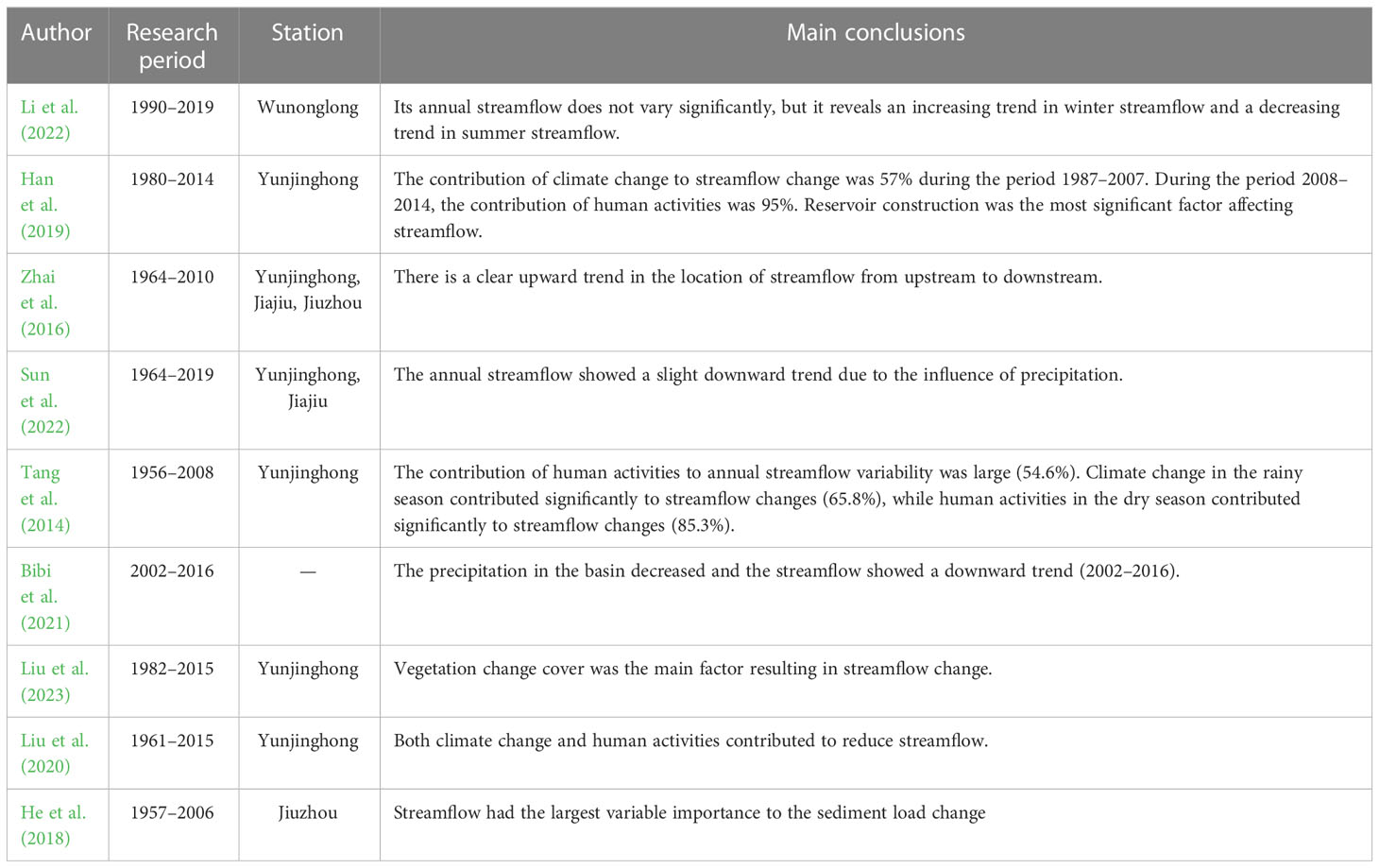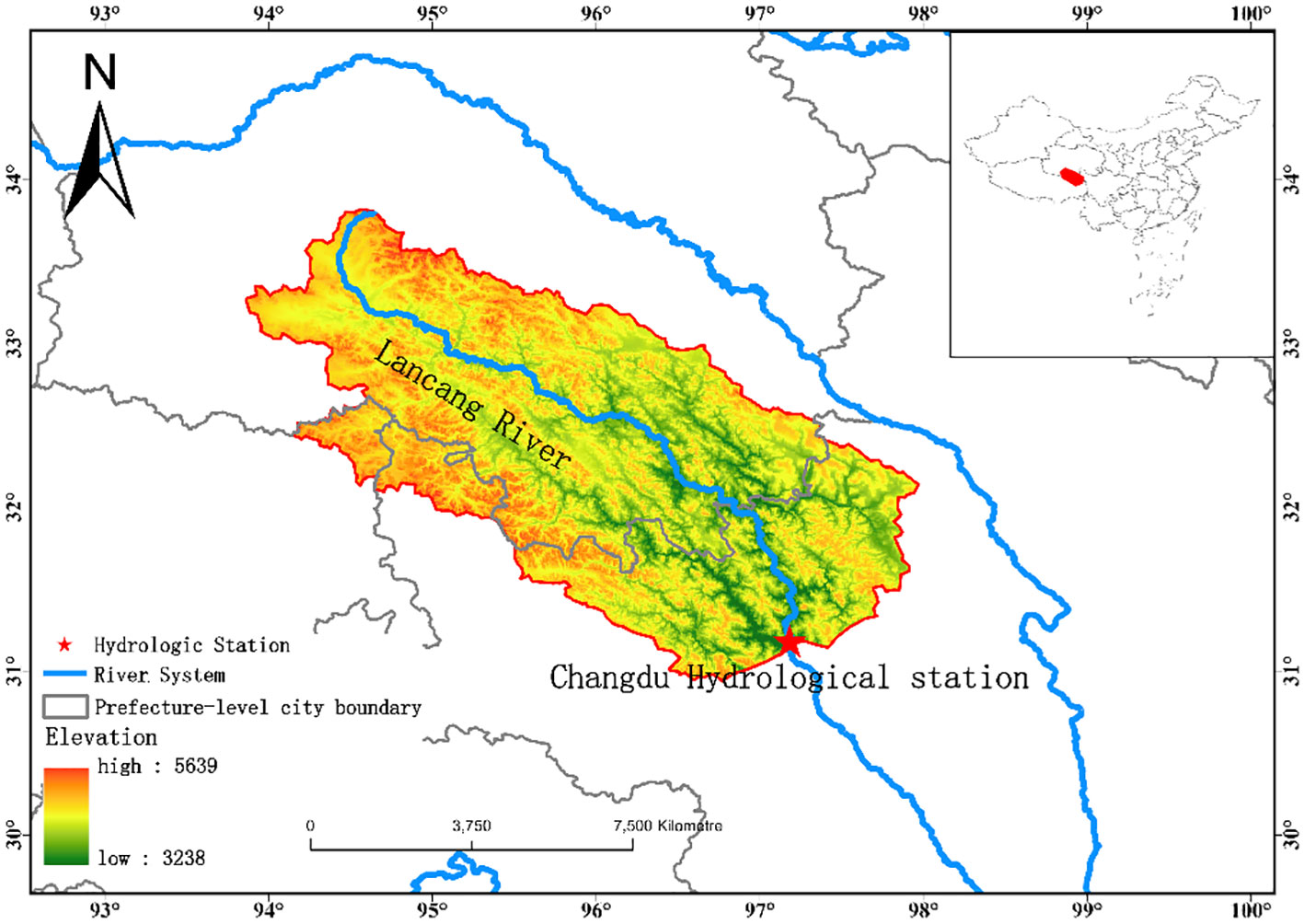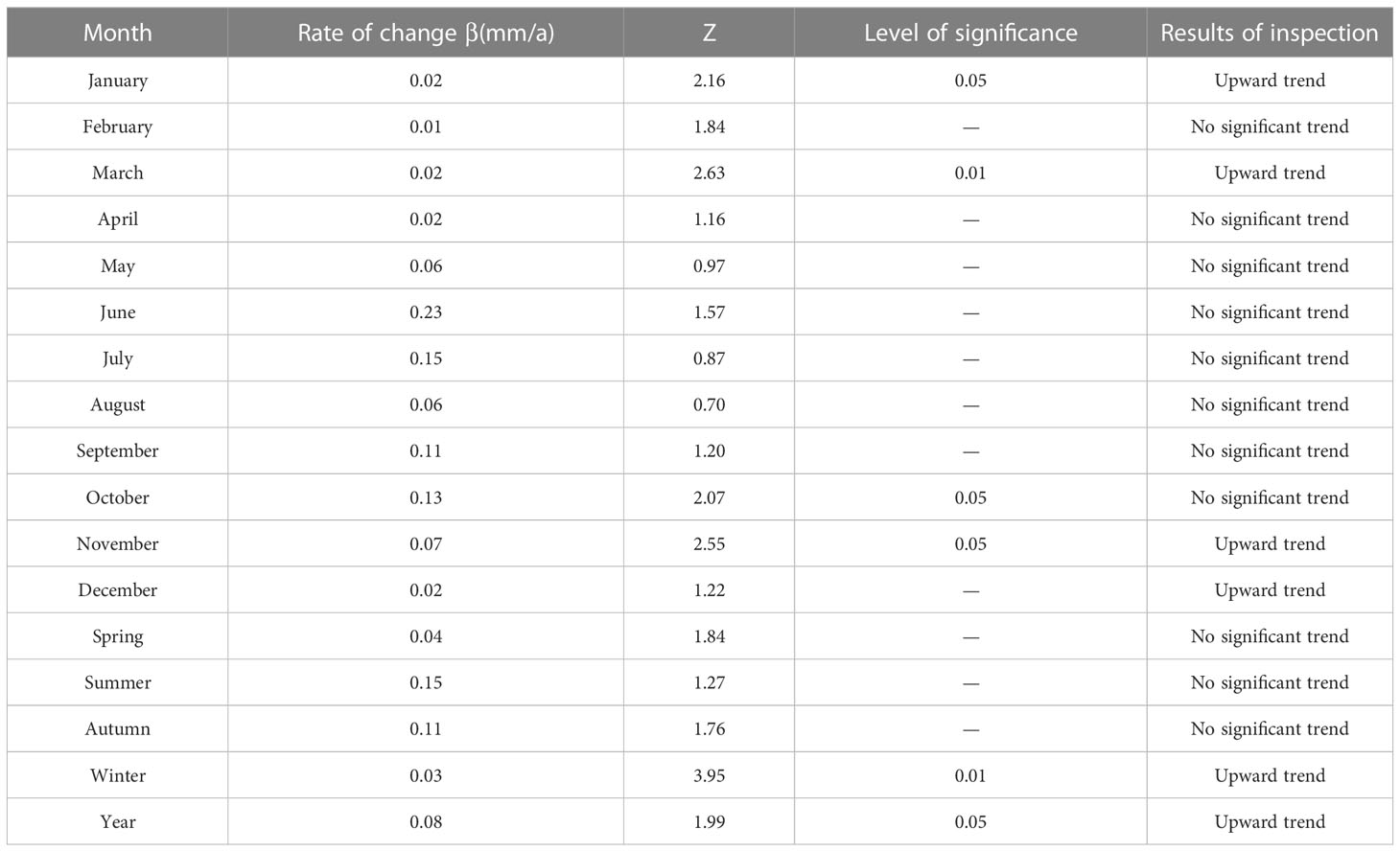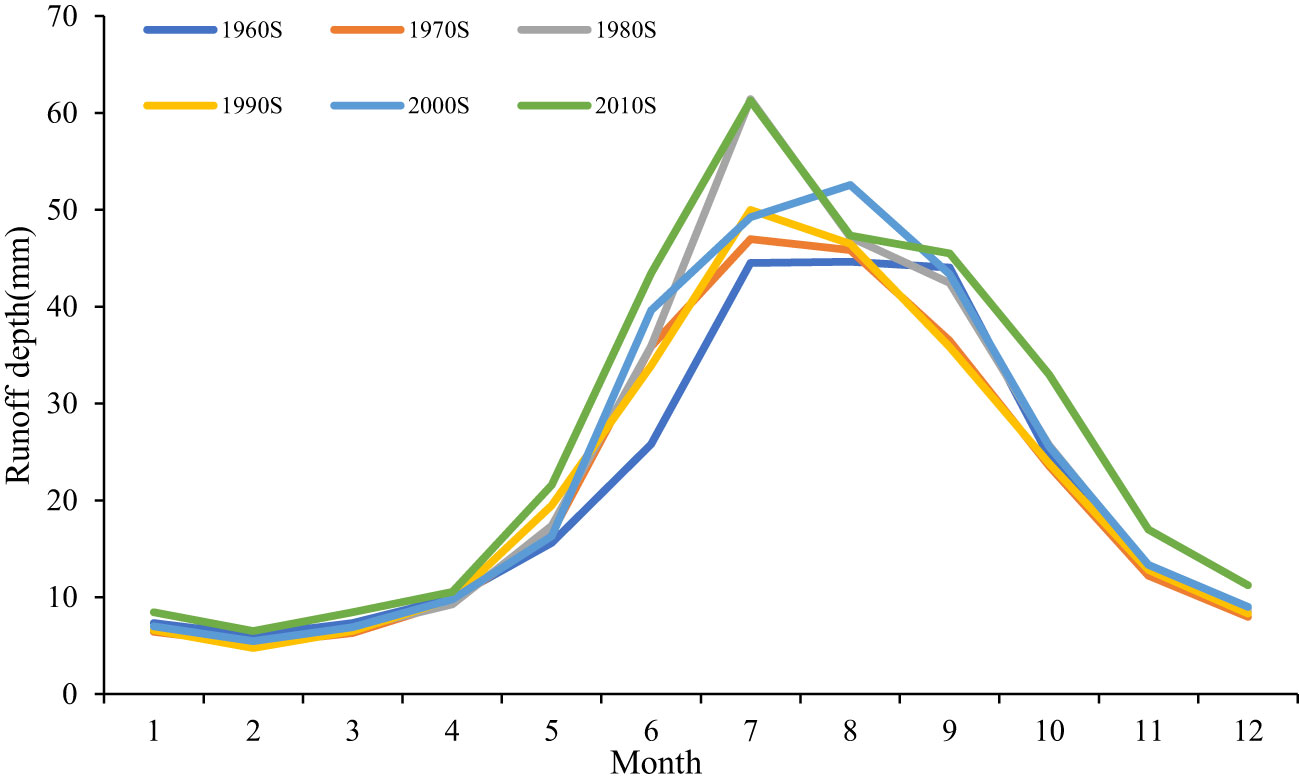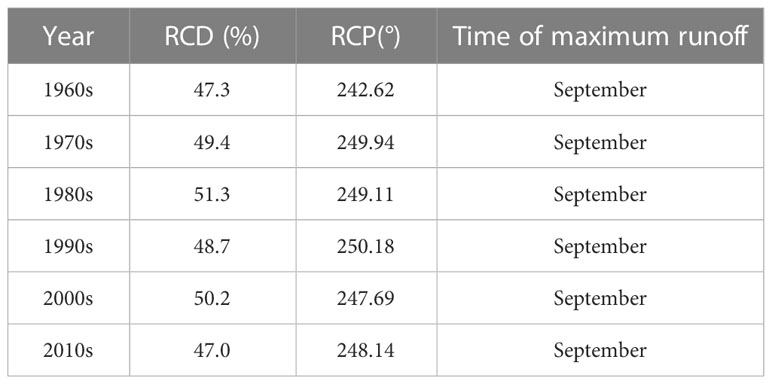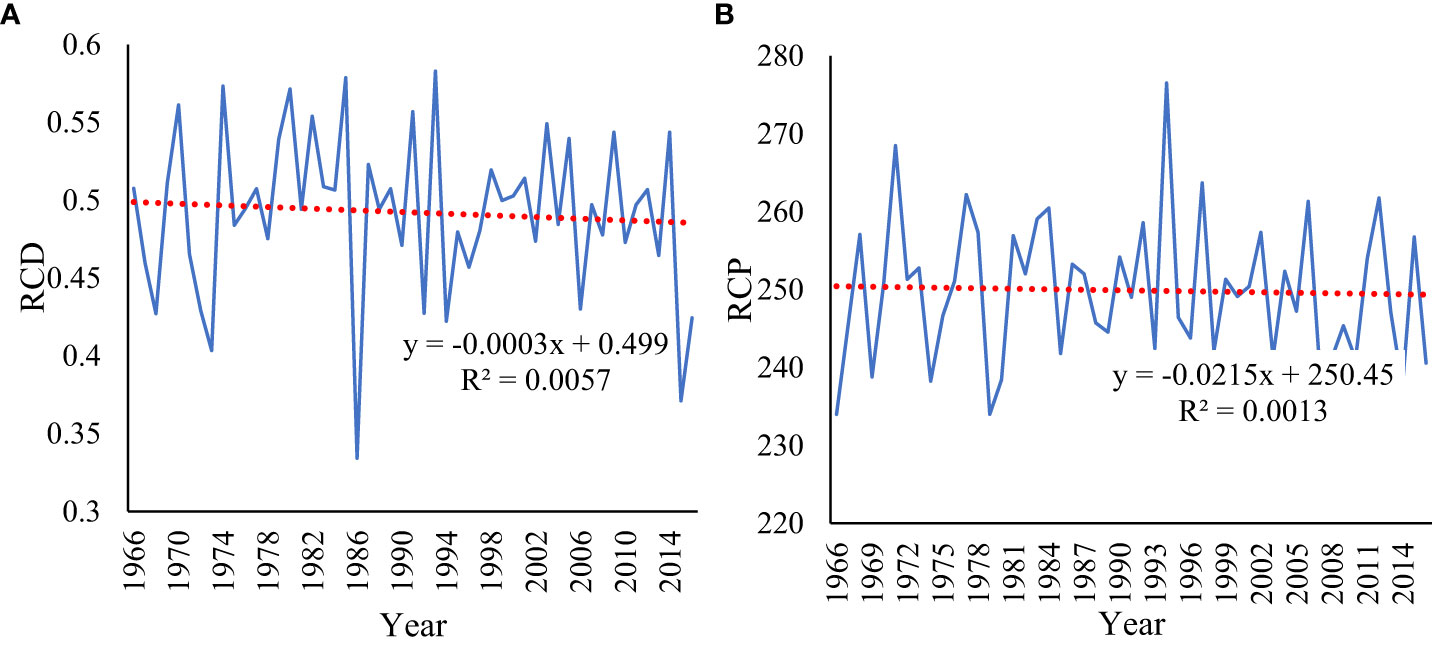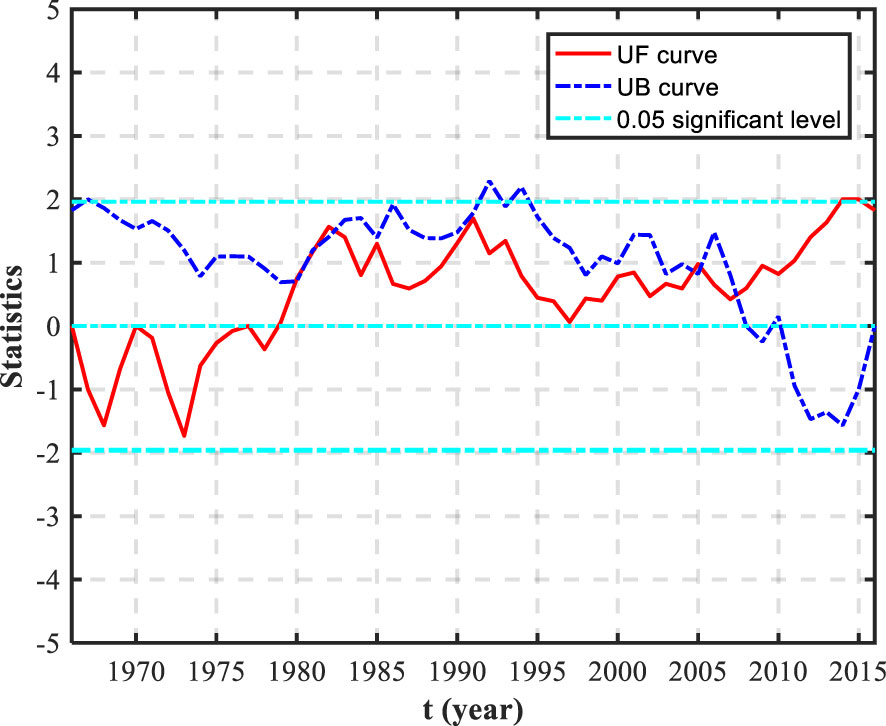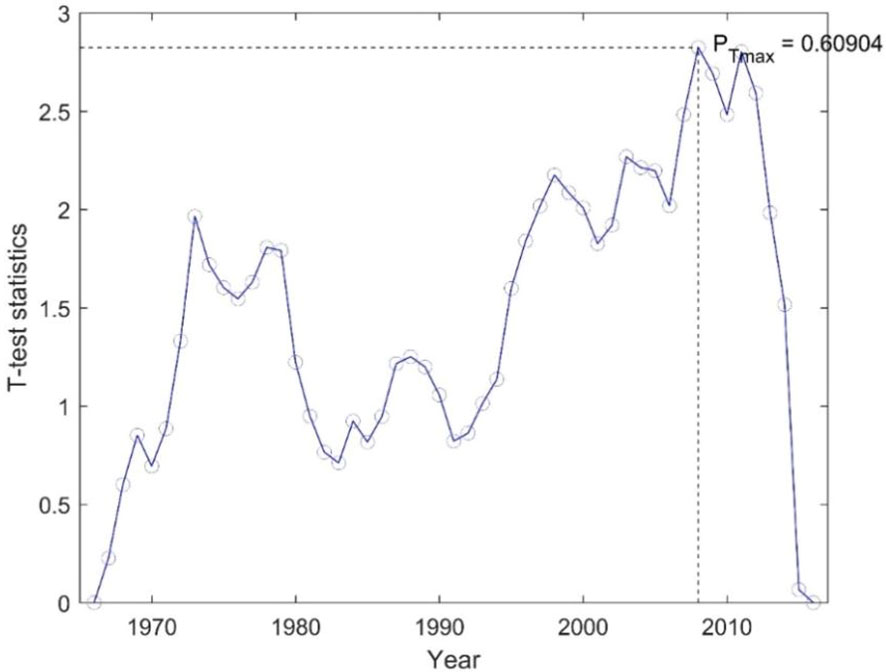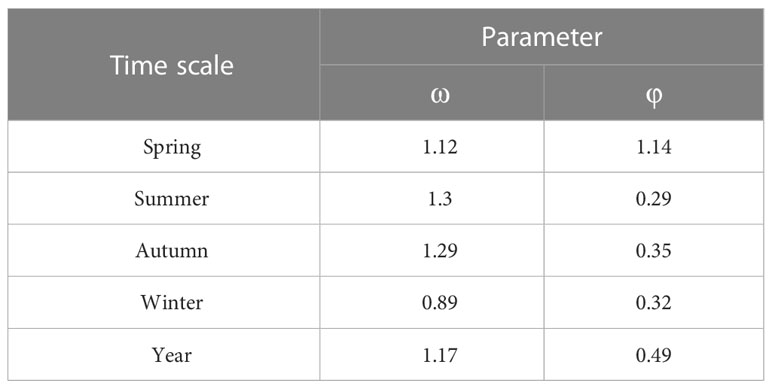- College of Resources and Environmental Sciences, Henan Agricultural University, Zhengzhou, China
Under the influence of climate change and human activities, the intra-annual distribution characteristics of streamflow have changed, directly affecting the exploitation of water resources and the health of ecosystems. The trend-free pre-whitening Mann-Kendall (TFPW-MK) test method, concentration degree and concentration period, and Bernaola-Galvan (BG) segmentation algorithm were applied to analyze variation trend, intra-annual distribution characteristics, and abrupt year of streamflow. Then, the monthly water storage and monthly actual evaporation of the source area of the Lancang River (SALR) were calculated by the monthly ABCD model. Finally, the contributions of different factors to runoff variability at multiple time scales were quantified using the seasonal-scale Budyko hypothesis approach. The results showed that: (1) The runoff revealed a significant upward trend on the annual scale. Runoff exhibited a significant upward trend in January, October and November, and runoff in other months and seasons exhibited an insignificant upward trend. (2) The intra-annual distribution characteristics of runoff in the SALR showed an obvious “Single-peak type“ distribution, reaching a maximum in July and August. (3) The year of sudden change in streamflow was 2008. (4) The contribution of climate change and human activities to the annual runoff change was 83.3% and 16.7%, respectively. The degree of influence of climate change on runoff change was ranked as spring (96.8%), autumn (85.3%), winter (82.2%) and summer (58.2%). The order of impact of human activity on runoff change was summer (41.8%), winter (17.8%), autumn (14.7%), spring (3.2%).
1 Introduction
Global climate change changes the status of the hydrological cycle, affecting precipitation, evaporation and runoff, directly or indirectly changing the quantity and spatial and temporal distribution of water resources (Yan et al., 2020a; Ji et al., 2022a). In the past 50 years, the global climate has undergone significant changes, mainly in terms of temperature increase (Han and Wang, 2016; Huang et al., 2016). Precipitation and evaporation have been altered at global and regional scales, with significant impacts on watershed and regional water resources (Jay and Thomas, 2000; Liepert and Romanou, 2005; Zeng et al., 2007). At the same time, excessive human activities and rapid urbanization have led to dramatic changes in the underlying surface of the basin, affecting its hydrological cycle (Milly et al., 2005; Abbott et al., 2019). The intra-annual distribution of streamflow changes under the combined influence of climate change and human activities (Petts et al., 1999; Rossi et al., 2009; Guo et al., 2020). Runoff is an important resource related to natural environmental change, directly affecting agricultural irrigation and production, ecological protection and restoration, and economic development (Parry et al., 2004; Piao et al., 2010; Qin et al., 2020; Ji et al., 2023a). Therefore, it is important to explore the influence of human and climatic factors on streamflow changes. For example, Climate change and human activities can affect the intra-annual distribution characteristics of streamflow in the Yellow River headwaters (Zheng and Liu, 2003). The contribution of climatic and anthropogenic factors to streamflow changes in the Yellow River basin from 1961 to 2015 was 75.33% and 24.67%, respectively (Yan et al., 2020b). Therefore, understanding the evolution of streamflow is conducive to understanding the influence mechanisms of climatic factors (precipitation, evapotranspiration and soil water storage) and human activities (factors other than precipitation, evaporation and soil water storage) on streamflow changes, and can also provide theoretical guidance for ecological environmental protection and efficient use of water resources.
The Lancang River (LR) originates in the northeastern Tanggula Mountains in Qinghai Province, China. During the past four decades, precipitation in the LR basin has shown a significant downward trend due to climate change (Li et al., 2017; Dou et al., 2019; Wang et al., 2022b). The agricultural water consumption of the LR is basically stable, and the water consumption for industry and domestic use is gradually increasing (Gao et al., 2016). Under the general trend of global warming, it is necessary to carry out research on the characteristics of water resources changes in the LR basin. Some scholars have analyzed the characteristics of streamflow changes in the LR basin (Table 1).
However, The Lancang River is a highly distinctive basin. Some scholars have studied the contribution of certain factors to streamflow changes in the Lancang River basin and other basins, and fewer studies have analyzed the contribution of different factors on multi-temporal scale streamflow variation in the source area of the Lancang River (SALR). Therefore, we will investigate a study on the attribution analysis of multi-temporal scale streamflow changes in the SALR.
In order to understand the impact of different factors on multi time scale streamflow changes in the source area of the Lancang River (SALR), we were committed to analyzing the characteristics of multi time scale changes in the SALR, and quantitatively calculating the contribution rates of different factors and multi time scales to streamflow changes. 1) The trend-free pre-whitening Mann-Kendall (TFPW-MK) test was devoted to analyze the monthly, seasonal and annual runoff of the trend of runoff variation. 2) The concentration degree and concentration period were used to analyze the annual distribution characteristics of runoff. 3) The M-K mutation test method and BG segmentation algorithm were devoted to determine the sudden change year of streamflow. 4) The ABCD hydrological model was applied to emulate monthly-scale runoff changes at Changdu hydrological station. 5) The seasonal scale Budyko hypothesis was applied to attribution analysis of multi-temporal scale runoff changes at Changdu hydrological station. This study reveals the evolution of streamflow patterns and drivers at multiple time scales in the SALR, which can provide a scientific basis for the efficient use of water resources in the basin.
2 Data and research methods
2.1 Study area and data
The Lancang River originates in the northeast side of the Tanggula Mountains in Qinghai and flows through Qinghai, Tibet and Yunnan provinces (Zou et al., 2008). It is known as the Mekong River after flowing out of Mengla County in Xishuangbanna Dai Autonomous Prefecture, Yunnan Province (Wang et al., 2022a). The Lancang River is about 2179 km in China, with a natural drop of 4583 m and a catchment area of about 165,000 km2 (Li et al., 2022). Its main geomorphological features are staggered distribution of high mountains and valleys (He, 1995; Tang, 1999; Zhang et al., 2015). The watershed between Zaduo and Changdu belongs to the transition area of the canyon, and the water system in the region is more developed, and the dry and tributary streams are more oblique confluence. Changdu to Wunonglong is dominated by high mountain and canyon terrain, with short tributaries (Chen et al., 2000). The LR is mainly controlled by the south-west and north-east monsoons. Winters are sunny and dry under the influence of the north-east monsoon. Influenced by the south-west monsoon, there is a lot of cloud and rain in summer. The SALR is an alpine zone. The spatial distribution of precipitation decreases from south-east to north-west. The average annual precipitation in the eastern part of the basin is more than 500 mm, while in the western part it is around 250 mm (Dou et al., 2019). Sparse population and low exploitation of water resources. Grassland (45.84%), forest land (35.82%) and cropland (17.09%) are the main land use types in the SALR (Bibi et al., 2021). The main changes in land use during the study period were a decrease in the area of cropland and woodland, and an increase in the area of grassland.
As the Changdu hydrological station is the control hydrological station for SALR, therefore we used the streamflow data from this hydrological station to analyze the characteristics of streamflow variability at multiple time scales in the SALR. The monthly streamflow data of Changdu hydrological station from 1966–2016 were derived from the Hydrological Yearbook and the National Center for Earth System Science Data (www.geodata.cn). Meteorological data were derived from China Meteorological Data Network (http://data.cma.cn). Based on the data, we analyzed the characteristics of streamflow variation in the SALR. Figure 1 shows the location of SALR and Changdu hydrological station.
2.2 Research methodology
2.2.1 TFPW-MK trend analysis method
The rank-order non-parametric statistical test, Mann-Kendall, does not require the sample to obey certain distributional characteristics and is less susceptible to interference from a few outliers. However, as the runoff time series are highly autocorrelated and the presence of autocorrelation affects the magnitude of the MK test statistic, in particular, positive autocorrelation amplifies the significance of the time series. Therefore, the trend-free pre-whitening Mann-Kendall (TFPW-MK) test method was used for analyzing the variation trend of time series data (Yue and Wang, 2002). The method improves the accuracy of the hypothesis testing of the time series without weakening the trendiness of the time series and is a more reasonable test (Xv et al., 2006).
2.2.2 Concentration degree and concentration period
This method treats the runoff volume of all months in a year as vectors. The magnitude of the monthly runoff is the modulus of that month’s runoff and the month in which it is located is the direction of the runoff vector. The azimuths of the locations where the srunoff vectors are located from January to December are 0°, 30°, 60°, …, 330° (December). Find the sum of the horizontal component (Rx) and vertical components (Ry) of the 12-month runoff volume and find the synthetic vector of runoff (R) (Sun, 2022a).
Where, is the runoff volume in month , is the vector angle of runoff in month , and is the monthly sequence (= 1, 2, 3,…,12).
The ratio of the modulus of the synthetic vector to the annual runoff (Ryear) is the Runoff concentration degree (RCDyear), and the ensemble vector direction is the Runoff concentration period (RCPyear).
The maximum value is reached when RCDyear is 1. If the runoff is relatively average across the months, the RCDyear is approximately equal to 0 and the concentration degree is a minimum, i.e. it indicates that the runoff is relatively evenly distributed across the 12 months (Zheng and Liu, 2003).
2.2.3 Mutation test method
Mann-Kendall mutation test’s advantages are that it does not require the sample to follow a certain distribution, it is not disturbed by a few outliers, and it is easy to calculate (Gong and Jin, 2009; He et al., 2013; Ji et al., 2021a). In this paper, the M-K mutation test is devoted to determine the time region in which the mutation occurred. Analyzing the plotted UF and UB graphs, if the value of UF or UB is greater than 0 it indicates an upward trend of the series, and less than 0 indicates a downward trend. If there is an intersection of the two curves UF and UB and the intersection point is between the critical lines, then the moment corresponding to the intersection point is the time when the mutation starts (Wang et al., 2015; Huang et al., 2016a; Yan et al., 2020b).
The Bernaola-Galvan (BG) segmentation algorithm is an effective method for detecting non-linear, non-smooth time series (Bernaola-Galván et al., 2001). The BG segmentation algorithm is suitable for mutation monitoring of non-stationary time series and can accurately detect mutation points. Using the th point as the time series cut-off point, calculate the mean , and standard deviation , of the left and right segments of the ith point (=1, 2, 3,…, −1). The t-test statistic and the combined deviation at the ith point are as follows (Sun et al., 2014).
Calculating the t-test statistic for each data in turn from left to right yields a T-series from which the maximum is found as well as the index . If the statistical significance ( is a given parameter), the series can be split at the jth sample, i.e. the mutation point (Jiang et al., 2015).
, , n is a sample of the time series, , is an incomplete function.
Similarly, the above operation can be repeated for the two subsequences after the split until they are indivisible. To ensure statistical validity, if the subsequence length is less than or equal to , the subsequence will not be split (Liu et al., 2023). Normally, is taken in the range of 0.50 to 0.95 and should not be less than 25(Feng et al., 2005).
2.2.4 ABCD hydrological model
The ABCD model consists of two water storage components: the soil aquifer and the groundwater layer, the basic principle of which is the water balance principle. The equation for the water balance in a soil aquifer can be expressed as (Ji et al., 2021b):
Where Pt is the monthly rainfall; ETt is the actual monthly evaporation (mm); DRt is the direct surface runoff (mm); GRt represents the groundwater recharge (mm); St and St1 represent the current and previous month’s soil water content (mm). Effective water volume Wt and possible evaporation Yt:
The probable evaporation Yt is the maximum amount of water that can leave the watershed in the form of evaporation, while the effective water Wt is the sum of the probable evaporation and the outflow from the soil aquifer. The possible evaporation Yt is expressed as (Guo et al., 2022):
Where a is the probability of forming runoff before the soil is fully saturated; parameter b is the upper limit of unsaturated aquifer storage capacity.
The ABCD model assumes that the ratio between the rate of decrease in soil water content S due to evapotranspiration and the potential evapotranspiration is St/b,i.e.:
Where, PETt represents the potential evaporation, and the potential evaporation is calculated using Penman’s formula (Ji et al., 2021c):
Where, indicates the slope of the saturation vapour pressure versus temperature curve (kPa °C−1). denotes the wind speed at 2 m (m/s). and are the saturation vapour pressure at air temperature (kPa) and the actual vapour pressure of the air (kPa) respectively. For the groundwater layer component, the water balance equation is:
Where, GDt is groundwater runoff; GRt is groundwater recharge; Gt and Gt1 are groundwater storage in the current month and the previous month, respectively. Groundwater recharge GRt and subsurface runoff GDt can be expressed respectively as follow (Zhuang et al., 2022).
Where, parameter c is the proportion of groundwater recharge from the soil aquifer; parameter d is the rate of groundwater formation outflow; DRt+GDt is the sum of surface runoff and subsurface runoff.
The mean square error or deterministic coefficient of simulated runoff and measured runoff can be used as an objective function for model parameter preferences. In this paper, the Nash coefficient is chosen as the objective function for model parameter preference. NSE is denoted as follow.
Where, N is the length of the sample series; is the simulated runoff depth (mm); is the measured runoff depth (mm); is the average value of the measured runoff (mm).
2.2.5 Seasonal scale Budyko model
There are there presuppositions for the Budyko formula, which was applied for quantitatively computing the contribution of different factors to runoff: 1) human factor, climatic factor and vegetation are independent; 2) The runoff change in the base period is only affected by climatic factor; 3) Except for runoff changes caused by precipitation, potential evapotranspiration, and vegetation changes, all other factors that affect runoff changes are unanimously considered as human factors (Yang et al., 2008; Caracciolo et al., 2018; Zhang et al., 2019; Li et al., 2020).
The equation is based on the seasonal scale Budyko model and expressed as Turc-Pike form (Chen et al., 2013; Li et al., 2020; Ji et al., 2021b).
Where, is the drought index; is the evaporation rate; φ is the lower bound of the drought index; ΔS denotes the soil water storage variable; ω denotes the characteristic parameter of the subsurface (Caracciolo et al., 2018).
The vertical decomposition approach considers that climate change affects runoff by altering effective precipitation and potential evapotranspiration. And what human activities change is the proportion of effective precipitation distributed between evaporation and runoff. There is a change in ΔS at the seasonal scale, and the model assumes that if there is no human activity, when P and Ep change, ΔS changes accordingly (Wang and Alimohammadi, 2012). In this study, the horizontal variable is the potential evaporation divided by the effective precipitation, which is influenced only by climate change. The vertical variable is actual evaporation divided by effective precipitation, which is influenced by both human activity and climate change.
The effects of climate change can induce both horizontal and vertical components, both of which can affect runoff, but direct anthropogenic disturbance factors can only affect the vertical component. An expression to calculate the contribution of human disturbance to runoff changes, and an expression for the ratio of runoff divided by precipitation evaporation, are shown below (Wang and Hejazi, 2011):
and are the values of the vertical coordinates of two points with the same horizontal coordinate in the model, respectively. R1 and R2 are the runpff depth of two periods, respectively, and the total runoff depth variation is . The change in runoff due to climate change () is the difference between and the change in runoff due to human activities ().
Thus, the equation for the contribution of climate change and human activities to the amount of runoff change can be derived as:
3 Results and analysis
3.1 Trend analysis
In this paper, the TFPW-MK trend test approach was devoted to dissect the change trend of monthly, quarterly, and annual runoff. From the rate of change of runoff in Table 2, the slope of runoff is greater than zero on either the monthly, seasonal or annual scales. The runoff showed a significant upward trend at the 0.05 level of significance in January, October and November. The runoff of March showed a significant upward trend at the 0.01 level of significance. The rest of the months showed a non-significant trend in runoff. On a seasonal scale, the runoff of all seasons showed a non-significant trend, except for winter, which showed a significant upward trend at the 0.01 level of significance. On an annual scale, runoff showed a significant upward trend at the 0.05 level of significance. This may be due to winter snowfall and the fact that the surface temperature is not low enough to cause an increase in snowmelt runoff. October coincided with the flood season and increased precipitation, resulting in a significant trend of increased runoff.
3.2 Intra-year change characteristics
From Figure 2, the runoff depth in the SALR appeared a clear “Single-peak type” distribution at all periods. Runoff depth was at a low value from January to March, began to rise slowly from April to May, rose significantly from June onwards, reached a basic maximum in July or August, and tended to fall significantly from September to November until it reached a minimum in December. Therefore, the runoff in the SALR was mainly concentrated in June–August, this coincided with the fact that atmospheric precipitation in the region was mainly distributed from June to August.
Table 3 lists the RCD, RCP and the time of maximum runoff occurrence for each decade from 1966–2016 in the SALR. RCD showed an upward trend between the 1960s and 1980s, and a fluctuating downward trend between the 1980s and 2010s. Overall, RCP showed a downward trend. The RCP of each period were mainly concentrated in 242°–251°. The time of maximum runoff all occurred mainly in September.
Figure 3 presented the inter-annual trend of RCD and RCP in the SALR from 1966 to 2016. The linear regression slope of RCD in the SALR was −0.0003 in Figure 3A. This indicated an overall non-significant decreasing trend. The linear regression slope of RCP in the SALR was −0.0215 in Figure 3B. This indicated an overall non-significant downward trend of the RCP.
3.3 Abrupt change analysis
M-K mutation test approaches were applied to identify the abrupt change characteristics of streamflow series data in the SALR from 1966–2016 (Figure 4). Figure 4 displayed that UF and UB intersected in 1980, 1982, 2005, and 2008, and the intersection points were all within the 0.05 significance level line, which indicated that 1980, 1982, 2005, and 2008 might all be mutation year of the streamflow in tha SALR. In order to clarify the mutation year of streamflow, we will use the BG segmentation algorithm to further analyze the mutation year.
In this study, the BG segmentation algorithm were applied to identify abrupt years in the annual streamflow variation process at the Changdu hydrological station in the SALR basin. Figure 5 shows the statistical results of the T-test based on the BG segmentation algorithm. Calculating the T-test statistics for each year to measure the variability of the mean values of two subsequences. The year with the largest T-test statistic (Tmax) may be the year of mutation. The largest T-test statistics is about equal to 2.8 and occur in 2008, implying that the mutation year of annual streamflow in Changdu station may occur in 2008. Calculating the significance probability P(Tmax) corresponding to the largest T-test statistic (Tmax). The greater the P(Tmax), the better the significance. The basic parameter range is set between (0.5–0.95), it is generally considered plausible to take the value between this range, and in this paper, in order to distinguish it from other points as a distinction, we took a different value according to its actual situation, i.e., the parameter P0 was set to 0.60 in this study, and was set to 25. Therefore, P(Tmax) is 0.60904 and is greater than 0.60 (P0), which proved that annual streamflow of Changdu station mutated in 2008. should not be less than 25. Combining the M-K mutation test and BG segmentation algorithm, we considered 2008 as the year of abrupt change in the streamflow of LR basin.
3.4 Hydrological simulation
Since the abrupt change year was 2008, the research period were divided into base period (1966–2008) and mutation period (2009–2016), and the ABCD model runoff simulation was applied for simulating runoff variation process of base period (1966–2008) and mutation period (2009–2016). Table 4 shows the parameters and Nash coefficients of the ABCD model. Figures 6A, B compared the measured runoff with the simulated runoff results in the base period and mutation period respectively. The simulated and measured runoff for the base and abrupt change periods fitted well, and the Nash coefficient was 0.80 for the base period and 0.75 for the mutation period, indicating that the ABCD model has performed a good simulation of the runoff in the watershed and had high accuracy in runoff simulation. The simulation results of this basin were good and could provide data support for subsequent calculations.
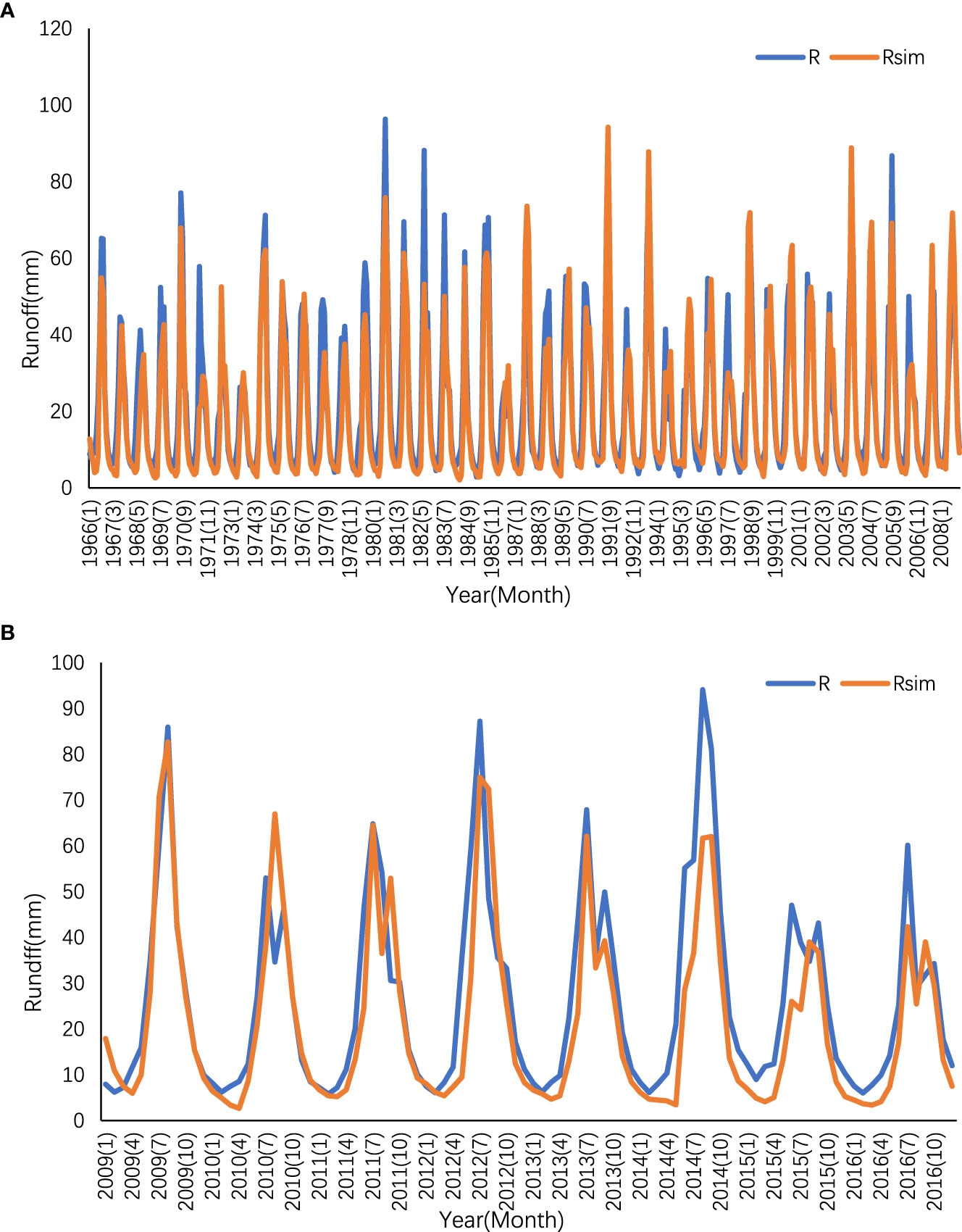
Figure 6 Comparison of the observed runoff and simulated runoff in the base period (A) and mutation period (B).
3.5 Attribution analysis of multi-temporal scale runoff change
For analyzing the effects of climate change and human activities on runoff using the seasonal-scale Budyko scenario approach, Budyko curves of different time scale in the base period were first fitted using the least squares method. Table 5 shows the parameters value of Budyko curves in the base period.
The values of precipitation, potential evapotranspiration and water storage at different time scales in the base period and mutation period were calculated separately and are shown in Table 6. Compared to the base period (1966–2008), precipitation, potential evapotranspiration and water storage of spring during the mutation period (2009–2016) increased by 14.76mm, 7.63mm and 3.88mm respectively. The variation value of precipitation, potential evaporation and storage in summer were 15.88mm, 11.42mm and −10.51mm respectively. The change value of precipitation, potential evaporation and storage in autumn were 14.28mm, 7.27mm and −6.28mm respectively. In winter, the change value of precipitation, potential evaporation and storage were −2.76mm, 18.15mm and −13.18mm respectively. Annual precipitation was 42.15mm, potential evaporation was 44.47mm, water storage was −26.08mm and annual runoff was on the rise.

Table 6 Values of changes in precipitation, potential evapotranspiration and water storage at different time scales during the base period and mutation period.
Based on the simulation results of the ABCD hydrological model and the parameter values of the fitted Budyko curves in the base period, the effects of climate change and human activities on the seasonal and annual runoff changes were calculated, as shown in Figure 7. Compared to the base period (1966–2008), the contribution of climate change and human activities to annual runoff changes was 83.3% and 16.7% respectively. From a seasonal perspective, climate change contributed 96.8%, 58.2%, 85.3% and 82.2% to runoff changes in spring, summer, autumn and winter, respectively, in the mutation period (2009–2016). Therefore, climate factors played the main factor influencing seasonal runoff changes, and the contribution rates were ranked as spring > autumn > summer > winter.
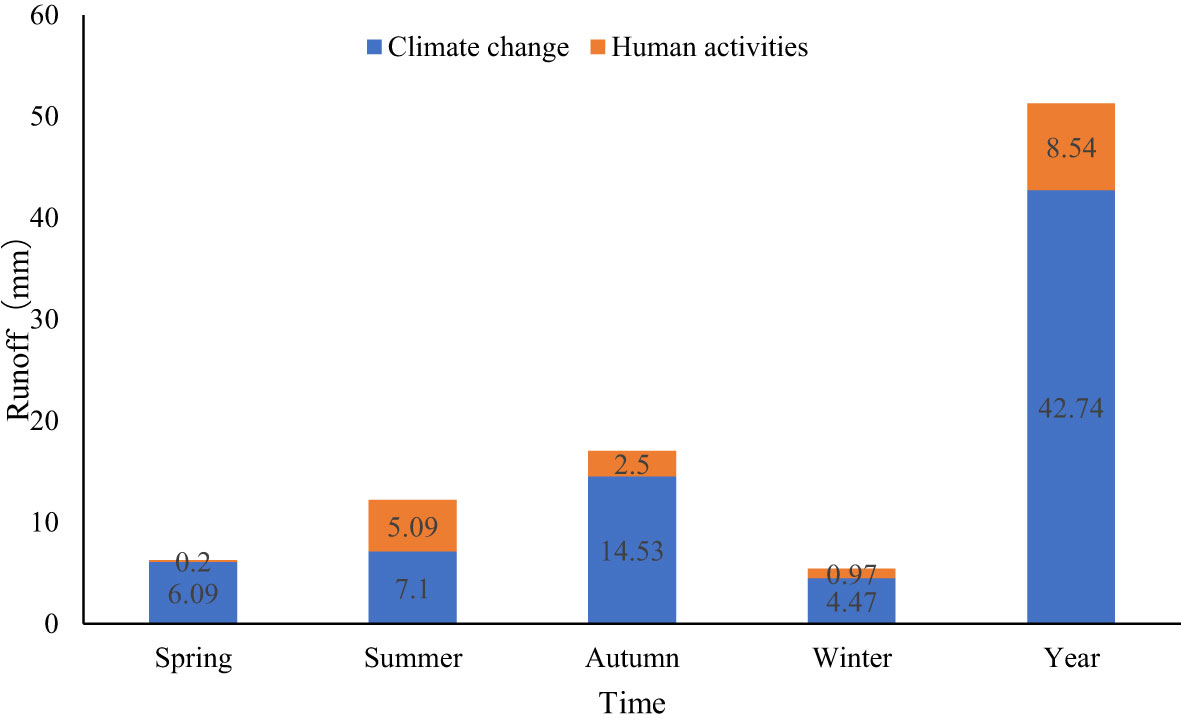
Figure 7 Calculations of climate change and human activities impacts on runoff in mutation period (2009–2016).
The main reason for the higher contribution rate of climate variation in spring, autumn and winter may be that the overall temperature and precipitation on the Qinghai Tibet Plateau have increased in recent decades. The runoff depth change value of summer between base period and mutation period is relatively large, and human activity contributed 41.8% to runoff changes of summer in the mutation period (2009–2016). This may be caused by the melting of summer ice and snow. In this paper, we classified factors other than precipitation and evaporation as human activities, therefore, the melting of summer ice and snow was classified as human activities.
4 Conclusion and discussion
In this paper, based on the monthly measured streamflow data from 1966–2016 at the Changdu hydrological station in the SALR, firstly we applied the TFPW-MK trend test, concentration degree and concentration period to analyze the change trends and intra-annual distribution characteristics of runoff at different time scales. The Mann-Kendall mutation test and the BG segmentation algorithm were then combined to determine the mutation year of runoff. Then, the monthly water storage and monthly actual evaporation of the source area of the Lancang River (SALR) were calculated by the monthly ABCD model. Finally, the contribution of different factors to the multiple time scales runoff variability were quantified using the seasonal scale Budyko model. The following conclusions were drawn.
1. The runoff in the SALR showed a significant upward trend in January, October and November and winter. This may be due to winter snowfall and the fact that the surface temperature is not low enough to cause an increase in snowmelt runoff. October coincided with the flood season and increased precipitation, resulting in a significant trend of increased runoff.
2. The intra-annual distribution of runoff in the SALR showed an obvious “Single-peak type” distribution, with maximum runoff in July and August, with no significant inter-annual variation. There was no significant downward trend in the concentration degree and concentration period, and the maximum runoff occurred in September.
3. Combining the M-K mutation test and BG segmentation algorithm, the year of abrupt change of streamflow in the SALR was determined to be 2008. The Nash coefficients of ABCD hydrological model for the base period and abrupt change period were 0.80 and 0.75, which proved that the ABCD monthly hydrological model could well simulate the monthly runoff variation of Changdu hydrological station.
4. Both climate change and human activities had a positive effect on annual runoff growth, with contributions of 83.3% and 16.7%, respectively. The degree of influence of climate change on runoff change was ranked as spring (96.8%), autumn (85.3%), winter (82.2%) and summer (58.2%). The order of impact of human activity on runoff change was summer (41.8%), winter (17.8%), autumn (14.7%), spring (3.2%).
The abrupt changes in the LR in 2008 are closely linked to climate change and human activities. Revegetation and planting are of great concern due to the high priority given to sustainable development in society. Changes in vegetation cover affect precipitation, potential evapotranspiration and substratum, and thus changes in streamflow. In the process of vegetation planting and restoration, the reduction in streamflow will be controlled. However climate change is an important factor influencing vegetation growth (Liu et al., 2023). The impact of human activities on streamflow can be directly or indirectly influenced by the construction of hydraulic engineering facilities that alter the quality, quantity and course of streamflow by changing the subsurface conditions. Human impact on streamflow through soil and water conservation, forestry and grazing, dams and diversions, etc (Arnell and Gosling, 2013; Van Vliet et al., 2013; Ji et al., 2022b).
This paper analyzed the trends of streamflow variation at different time scales and quantitative calculation of the contribution of different factors to multi-time scale streamflow variability. It also provides an important basis for water resources allocation and basin management in the SALR. We controlled the data and the used model precisely, but there are still some shortcomings in this study. We have used streamflow data from one hydrological station for the study, which is not fully representative of the actual situation of the whole river. Furthermore, in this paper, precipitation, evaporation and soil water storage are classified as climatic factors and other factors are classified as human activities, so there may be a lack of precision in carrying out the computational analysis. Moreover, the study ignored the reciprocal effect between climatic factor, vegetation and human factor (Wang et al., 2022; Gao et al., 2023), we should systematically quantify the influence of climatic conditions and anthropic factor interactions on eco-hydrological systems in the follow-up study (Wu et al., 2017; Al-Safi et al., 2020). Additionally, many glaciers are distributed in the SALR. In the context of global warming, the increase in snow melt and ice melt in the SALR basin due to the rise in temperature needs to be taken seriously. In the follow-up study, the contribution rate of glacier melting to streamflow change will be quantitatively analyzed (Ji et al., 2023b). The actual situation in the basin and the analysis of the intra-annual distribution of streamflow characteristics should be studied in depth and corresponding countermeasures should be taken in a timely manner.
Data availability statement
The original contributions presented in the study are included in the article/supplementary materials, further inquiries can be directed to the corresponding author.
Author contributions
Conceptualization: GJ. Methodology: ZL and GJ. Software: ZL and GJ. Validation: GJ. Formal analysis: ZL. Data curation: ZL and GJ. Writing—original draft preparation: ZL. Writing—review and editing: ZL, GJ, and WC. Visualization: YZ, JH and YG. Project administration: GJ and YZ. Funding acquisition: WC, JH, and YG. All authors have read and agreed to the published version of the manuscript.
Funding
This research was funded by the National Key R&D Program of China (2021YFD1700900), and the Special Fund for Top Talents of Henan Agricultural University (30501031), and the Henan Soft Science Research Project (232400410328), and the Research Project of Henan Federation of Social Sciences (2023-ZZJH-189).
Conflict of interest
The authors declare that the research was conducted in the absence of any commercial or financial relationships that could be construed as a potential conflict of interest.
Publisher’s note
All claims expressed in this article are solely those of the authors and do not necessarily represent those of their affiliated organizations, or those of the publisher, the editors and the reviewers. Any product that may be evaluated in this article, or claim that may be made by its manufacturer, is not guaranteed or endorsed by the publisher.
References
Abbott B., Bishop K., Zarnetske J., Minaudo C., Chapin F., Krause S., et al. (2019). Human domination of the global water cycle absent from depictions and perceptions. Nat. Geosci. 12, 533–540. doi: 10.1038/s41561-019-0374-y
Al-Safi H. I. J., Kazemi H., Sarukkalige P. R. (2020). Comparative study of conceptual versus distributed hydrologic modelling to evaluate the impact of climate change on future runoff in unregulated catchments. J. Water. Clim. Change 11, 341–366. doi: 10.2166/wcc.2019.180
Arnell N. W., Gosling S. N. (2013). The impacts of climate change on river flow regimes at the global scale. J. Hydrol. 486, 351–364. doi: 10.1016/j.jhydrol.2013.02.010
Bernaola-Galván P., Ivanov P. C., Amaral L. A. N., Stanley H. E. (2001). Scale Invariance in the nonstationarity of human heart rate. Phys. Rev. Lett. 87, 168105. doi: 10.1103/PhysRevLett.87.168105
Bibi S., Song Q., Zhang Y., Liu Y., Kamran M., Sha L., et al. (2021). Effects of climate change on terrestrial water storage and basin discharge in the lancang River Basin. J. Hydrol: Regional Stud. 37, 100896.
Caracciolo D., Pumo D., Viola F. (2018). Budyko’s based method for annual runoff characterization across different climatic areas: an application to United States. Water Resour. Manage. 32, 3189–3202. doi: 10.1007/s11269-018-1984-7
Chen X., Alimohammadi N., Wang D. (2013). Modeling interannual variability of seasonal evaporation and storage change based on the extended Budyko framework. Water Resour. Res. 49, 6067–6078. doi: 10.1002/wrcr.20493
Chen X. (2000). Compilation of basic information on the lancang-mekong river basin [M] (Kunming: Yunnan Science and Technology Press).
Dou X., Huang W., Yi Q., Liu X., Zuo H., Li M. G., et al. (2019). Impacts of LUCC and climate change on runoff in Lancang River Basin. Acta Ecologica Sin. 39 (13), 4687–4696. doi: 10.5846/stxb201811302610
Feng G., Gong Z., Dong W. (2005). Research on climate mutation detection based on heuristic segmentation algorithm. J. Phys. 54 (11), 5494–5499. doi: 10.7498/aps.54.5494
Gao Q., Guo Y., Xv H., Ganjurjav H., Li Y., Wan Y., et al. (2016). Climate change and its impacts on vegetation distribution and net primary productivity of the alpine ecosystem in the Qinghai-Tibetan Plateau. Sci. Total Environ., 554–555, 34-41. doi: 10.1016/j.scitotenv.2016.02.131
Gao H., Li Q., Xiong G., Li B., Zhang J., Meng Q. (2023). Quantitative assessment of hydrological response to vegetation change in the upper reaches of Luanhe River with the modified Budyko framework. Front. Ecol. Evol. 11, 1178231. doi: 10.3389/fevo.2023.1178231
Gong L., Jin C. (2009). Fuzzy comprehensive evaluation for carrying capacity of regional water resources. Water Resour. Manage. 23, 2505–2513. doi: 10.1007/s11269-008-9393-y
Guo W., Hong F., Yang H., Huang L., Ma Y., Zhou H., et al. (2022). Quantitative evaluation of runoff variation and its driving forces based on multi-scale separation framework. J. Hydrol: Regional Stud. 43(8):101183. doi: 10.1016/j.ejrh.2022.101183
Guo Y., Huang S., Huang Q., Leng G., Fang W., Wang L., et al. (2020). Propagation thresholds of meteorological drought for triggering hydrological drought at various levels. Sci. Total Environ. 712, 136502. doi: 10.1016/j.scitotenv.2020.136502
Han Z., Long D., Fang Y., Hou A., Hong Y. (2019). Impacts of climate change and human activities on the flow regime of the dammed Lancang River in Southwest China. J. Hydrol 570, 96-105. doi: 10.1016/j.jhydrol.2018.12.048
Han P., Wang X. (2016). Predicting the hydrological response of watersheds to climate extremes using the ABCD model. People's Yellow River 38 (11), 16–22. doi: 10.3969/j.issn.1000-1379.2016.11.005
He D. (1995). Analysis of the hydrological characteristics of the Lancang-Mekong River. Yunnan Geographic Environ. Res. 7 (1):58-73.
He Y., Gui Z., Su C. (2018). Response of sediment load to hydrological change in the upstream part of the lancang-mekong river over the past 50 years. Water 10, 888. doi: 10.3390/w10070888
He B., Miao C., Shi W. (2013). Trend, abrupt change, and periodicity of streamflow in the mainstream of Yellow River. Environ. Monit. Assess. 185, 6187–6199. doi: 10.1007/s10661-012-3016-z
Huang S., Chang J., Huang Q., Chen Y., Leng G. (2016). Quantifying the relative contribution of climate and human impacts on runoff change based on the budyko hypothesis and SVM model. Water Resour. Manage. 30, 2377–2390. doi: 10.1007/s11269-016-1286-x
Huang Q., Kong B., Fan J. (2016). Hydrological elements comprehensive detecting variation. Yellow River 38, 18–23. doi: 10.3969/j.issn.1000-1379.2016.10.004
Jay H., Thomas C. P. (2000). Pan evaporation trends in dry humid regions of the United States. J. Hydrometeorol 1 (6), 543–546. doi: 10.1175/1525-7541(2000)001<0543:PETIDA>2.0.CO;2
Ji G., Huang J., Guo Y., Yan D. (2022b). Quantitatively calculating the contribution of vegetation variation to runoff in the middle reaches of yellow river using an adjusted budyko formula. Land 11, 535. doi: 10.3390/land11040535
Ji G., Lai Z., Xia H., Liu H., Wang Z. (2021a). Future runoff variation and flood disaster prediction of the yellow river basin based on CA-markov and SWAT. Land 10, 421. doi: 10.3390/land10040421
Ji G., Lai Z., Yan D., Wu L., Wang Z. (2022a). Spatiotemporal patterns of future meteorological drought in the Yellow River Basin based on SPEI under RCP scenarios. Int. J. Climate Change Strategies Management. 14 (1), 39–53. doi: 10.1108/IJCCSM-01-2021-0004
Ji H., Peng D., Gu Y., Luo X., Pang B., Zhu Z. (2023b). Snowmelt runoff in the yarlung zangbo river basin and runoff change in the future. Remote Sens. 15, 55. doi: 10.3390/rs15010055
Ji G., Song H., Wei H., Wu L. (2021c). Attribution analysis of climate and anthropic factors on runoff and vegetation changes in the source area of the yangtze river from 1982 to 2016. Land 10, 612. doi: 10.3390/land10060612
Ji G., Wu L., Wang L., Yan D., Lai Z. (2021b). Attribution analysis of seasonal runoff in the source region of the yellow river using seasonal budyko hypothesis. Land 10, 542. doi: 10.3390/land10050542
Ji G., Yue S., Zhang J., Huang J., Guo Y., Chen W. (2023a). Assessing the impact of vegetation variation, climate and human factors on the streamflow variation of yarlung zangbo river with the corrected budyko equation. Forests 14, 1312. doi: 10.3390/f14071312
Jiang C., Xiong L., Wang D., Liu P., Guo S., Xu C. Y. (2015). Separating the impacts of climate change and human activities on runoff using the Budyko-type equations with time-varying parameters. J. Hydrol. 522, 326–338. doi: 10.1016/j.jhydrol.2014.12.060
Li H., Shi C., Zhang Y., Ning T., Sun P., Liu X., et al. (2020). Using the Budyko hypothesis for detecting and attributing changes in runoff to climate and vegetation change in the soft sandstone area of the middle Yellow River basin, China. Sci. Total Environ. 703, 135588. doi: 10.1016/j.scitotenv.2019.135588
Li H., Wang G., Hao Z., Liu C., Liu P., Wu C., et al. (2017). Analysis of the variation characteristics of hydro-meteorological elements in the Lancang River basin. J. Water Resour. Water Eng. 28 (4), 21–27. doi: 10.11705/j.issn.1672-643X.2017.04.04
Li H., Zhang P., Guan Z. (2022). Analysis of runoff evolution characteristics in the upper watershed of Lancang River in recent 30 years [J/OL]. Journal of Yangtze River Scientific Research Institute, 1–7. doi: 10.11705/j.issn.1672-643X.2017.04.04
Liepert B., Romanou A. (2005). Global dimming and brightening and the water cycle. Bull. Am. Meteorology Soc. 86, 622–623. doi: 10.1029/2008JD011470
Liu Y., Chen W., Li L., Huang J., Wang X., Guo Y., et al. (2023). Assessing the contribution of vegetation variation to streamflow variation in the Lancang River Basin, China. Front. Ecol. Evol. 10, 1058055. doi: 10.3389/fevo.2022.1058055
Liu H., Wang Z., Ji G., Yue Y. (2020). Quantifying the impacts of climate change and human activities on runoff in the Lancang River basin based on the Budyko hypothesis. Water 12 (12), 3501. doi: 10.3390/w12123501
Milly P. C., Dunne K. A., Vecchia A. V. (2005). Global pattern of trends in streamflow and water availability in a changing climate. Nature 438, 347–350. doi: 10.1038/nature04312
Parry M. L., Rosenzweig C., Iglesias A., Livermore M., Fischer G. (2004). Effects of climate change on global food production under SRES emissions and socio-economic scenarios. Global Environ. Change 14, 53–67. doi: 10.1016/j.gloenvcha.2003.10.008
Petts G. E., Bickerton M. A., Crawford C., Lerner D. N., Evans D. (1999). Flow management to sustain groundwater-dominated stream ecosystems. Hydrological Processes. 13 (3), 497–513. doi: 10.1002/(SICI)1099-1085(19990228)13:3<497::AID-HYP753>3.0.CO;2-S
Piao S., Ciais P., Huang Y., Shen Z., Peng S., Li J., et al. (2010). The impacts of climate change on water resources and agriculture in China. Nature 467 (7311), 43–51. doi: 10.1038/nature09364
Qin Y., Abatzoglou J. T., Siebert S., Huning L., AghaKouchak A., Mankin , et al. (2020). Agriculture risks from changing snowmelt. Nat. Climate Change 10 (5), 459–465. doi: 10.1038/s41558-020-0746-8
Rossi A., Massei N., Laignel B., Sebag D., Copard Y. (2009). The response of the Mississippi River to climate fluctuations and reservoir construction as indicated by wavelet analysis of streamflow and suspended-sediment load 1950–1975. J. Hydrol. 377, 237–244. doi: 10.1016/j.jhydrol.2009.08.032
Sun L., Sun Z., Li Z., Zheng H., Li C., Xiong W. (2022). Response of runoff and suspended load to climate change and reservoir construction in the Lancang River. J. Water Climate Change 13 (4), 1966-1984. doi: 10.2166/wcc.2022.429
Sun R. (2022). “Analysis of concentration degree and concentration period of short-time heavy precipitation and difference analysis based on Morlet wavelet analysis. Advances in Social Science, Education and Humanities Research 634n. pag.
Sun Y., Tian F., Yang L., Hu H. (2014). Exploring the spatial variability of contributions from climate variation and change in catchment properties to streamflow decrease in a mesoscale basin by three different methods. J. Hydrol. 508, 170–180. doi: 10.1016/j.jhydrol.2013.11.004
Tang H. (1999). Resources, environment and sustainable development in the lancang-mekong river basin. Geogr. J. (S1), 101–109. doi: CNKI:SUN:DLXB.0.1999-S1-013
Tang J., Yin X., Yang P., Yang Z. (2014). Assessment of contributions of climatic variation and human activities to streamflow changes in the lancang river, China. Water Resour. Manage. 28 (10), 2963-2966. doi: 10.1007/s11269-014-0648-5
Van Vliet M. T. H., Franssen W. H. P., Yearsley J. R., Ludwig F., Haddeland I., Lettenmaier D. P., et al. (2013). Global river runoff and water temperature under climate change. Glob. Environ. Change 23, 450–464. doi: 10.1016/j.gloenvcha.2012.11.002
Wang D., Alimohammadi N. (2012). Responses of annual runoff, evaporation, and storage change to climate variability at the watershed scale. Water Resour. Res. 48 (5), W05546. doi: 10.1029/2011WR011444
Wang D., Hejazi M. (2011). Quantifying the relative contribution of the climate and direct human impacts on mean annual streamflow in the contiguous United States. Water Resour. Res. 47 (10), 411. doi: 10.1029/2010WR010283
Wang Y., Liu Z., Qian B., He Z., Ji G. (2022). Quantitatively computing the influence of vegetation changes on surface discharge in the middle-upper reaches of the huaihe river, China. Forests 13, 2000. doi: 10.3390/f13122000
Wang H., Tang J., Yu J., Xv Y., Yang Z., Ma J., et al. (2022b). Impacts of climate change on runoff in the Lancang River Basin, Yunnan. China Rural Water Hydropower (7), 90–96.
Wang S., Wang Y., Ran L., Su T. (2015). Climatic and anthropogenic impacts on runoff changes in the Songhua River basin over the last 56 years, (1955–2010), Northeastern China. Catena 127, 258–269. doi: 10.1016/j.catena.2015.01.004
Wang Y., Zhang L., Song Y. (2022a). Study on the construction of the ecological security pattern of the lancang river basin (Yunnan section) based on inVEST-MSPA-circuit theory. Sustainability 15 (1), 477. doi: 10.3390/su15010477
Wu J., Miao C., Wang Y., Duan Q., Zhang X. (2017). Contribution analysis of the long-term changes in seasonal runoff on the Loess Plateau, China, using eight Budyko-based methods. J. Hydrol. 545, 263–275. doi: 10.1016/j.jhydrol.2016.12.050
Xv J., Yang D., Lei Z., Li C., Peng J. (2006). Examination of long-term trends in precipitation and runoff in the Yangtze River Basin. Yangtze River (09), 63–67. doi: 10.3969/j.issn.1001-4179.2006.09.022
Yan X., Bao Z., Zhang J., Wang G., He R., Liu C. (2020a). Quantifying contributions of climate change and local human activities to runoff decline in the upper reaches of the Luanhe River basin. J. Hydro Environ. Res. 28, 67–74. doi: 10.1016/J.JHER.2018.11.002
Yan D., Lai Z., Ji G. (2020b). Using budyko-type equations for separating the impacts of climate and vegetation change on runoff in the source area of the yellow river. Water 12, 3418. doi: 10.3390/w12123418
Yang H., Yang D., Lei Z., Sun F. (2008). New analytical derivation of the mean annual water- energy balance equation. Water Resour. Res. 44, W03410. doi: 10.1029/2007WR006135
Yue S., Wang C. Y. (2002). Applicability of prewhitening to eliminate the influence of serial correlation on the Mann-Kendall test. Water Resour. Res. 38 (6), 4–1-4-7. doi: 10.1029/2001WR000861
Zeng Y., Qiu X., Liu C., Pan A., Gao P. (2007). Changes of pan evaporation in China in 1960-2000. Adv. Water Sci. 18 (3), 311–318.
Zhai H., Hu B., Luo X., Qiu L., Tang W. J., Jiang M. (2016). Spatial and temporal changes in runoff and sediment loads of the Lancang River over the last 50 years. Agric. Water Manage., 174, 74-81. doi: 10.1016/j.agwat.2016.03.011
Zhang X., Dong Q., Cheng L., Xia J. A. (2019). Budyko-based framework for quantifying the impacts of aridity index and other factors on annual runoff. J. Hydrol. 579, 124224. doi: 10.1016/j.jhydrol.2019.124224
Zhang J., Feng Z., Jiang L., Yang Y. (2015). Correlation analysis between NDVI and climate factors of vegetation in the Lancang River Basin. J. Natural Resour. 30 (09), 1425–1435.
Zheng H., Liu C. (2003). Analysis of the variation pattern of intra-annual distribution of runoff in the Yellow River source area. Prog. Geogr. 22 (6), 585–590. doi: 10.11820/dlkxjz.2003.06.006
Zhuang J., Xing Y. L. Y., Liu X., Yang Z., Zhao Z., et al. (2022). Attribution analysis of runoff change based on the abcd model coupled with the snowmelt module in the source region of the Yellow River. South-to-North Water Transfers Water Sci. Technol. 20 (5), 876–888. doi: 10.13476/j.cnki.nsbdqk.2022.0095
Keywords: streamflow changes, multiple time scales, attribution analysis, ABCD hydrological model, Budyko hypothesis
Citation: Liu Z, Chen W, Zhang Y, Huang J, Guo Y and Ji G (2023) Attribution analysis of multi-temporal scale changes of streamflow in the source area of Lancang River with seasonal scale Budyko model. Front. Ecol. Evol. 11:1229198. doi: 10.3389/fevo.2023.1229198
Received: 26 May 2023; Accepted: 28 July 2023;
Published: 18 August 2023.
Edited by:
Nir Krakauer, City College of New York (CUNY), United StatesReviewed by:
Biplov Bhandari, University of Alabama in Huntsville, United StatesQin Zhang, Dalian University of Technology, China
Copyright © 2023 Liu, Chen, Zhang, Huang, Guo and Ji. This is an open-access article distributed under the terms of the Creative Commons Attribution License (CC BY). The use, distribution or reproduction in other forums is permitted, provided the original author(s) and the copyright owner(s) are credited and that the original publication in this journal is cited, in accordance with accepted academic practice. No use, distribution or reproduction is permitted which does not comply with these terms.
*Correspondence: Guangxing Ji, Z3Vhbmd4aW5namlAaGVuYXUuZWR1LmNu
 Zhipei Liu
Zhipei Liu Weiqiang Chen
Weiqiang Chen Yulong Guo
Yulong Guo Guangxing Ji
Guangxing Ji